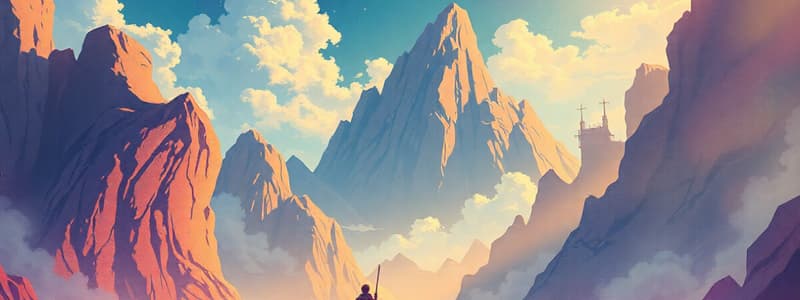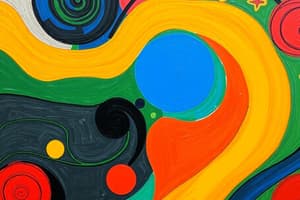Podcast
Questions and Answers
Which art form primarily creates works that are visual in nature?
Which art form primarily creates works that are visual in nature?
- Visual Arts (correct)
- Literary Arts
- Performing Arts
- Decorative Arts
Which of the following involves creative activity performed in front of an audience?
Which of the following involves creative activity performed in front of an audience?
- Ceramics
- Painting
- Sculpture
- Theatre (correct)
Which art movement is known for fracturing objects into geometric forms?
Which art movement is known for fracturing objects into geometric forms?
- Impressionism
- Cubism (correct)
- Surrealism
- Expressionism
Which of the following is a type of literary art?
Which of the following is a type of literary art?
What does art criticism primarily involve?
What does art criticism primarily involve?
Flashcards
Visual Arts
Visual Arts
Art that creates primarily visual works like painting and sculpture.
Performing Arts
Performing Arts
Art performed live, like theatre, music, and dance.
Literary Arts
Literary Arts
Creative writing, including poetry, novels, and drama.
Decorative Arts
Decorative Arts
Signup and view all the flashcards
Impressionism
Impressionism
Signup and view all the flashcards
Study Notes
- Art is a diverse range of human activities involving creative imagination to express technical proficiency, beauty, emotional power, or conceptual ideas.
Visual Arts
- Visual arts encompass forms that create works that are primarily visual in nature.
- Painting
- Sculpture
- Photography
- Printmaking
- Filmmaking
Performing Arts
- Performing arts involve creative activity that is performed in front of an audience.
- Theatre
- Music
- Dance
Literary Arts
- Literary arts include written creative work.
- Poetry
- Novels
- Short stories
- Drama
Decorative Arts
- Decorative arts are concerned with the design and manufacture of beautiful objects that are also functional.
- Ceramics
- Furniture
- Jewelry
- Textiles
Definition of Art
- Defining art is subjective and has varied throughout history.
- Art can be defined by its aesthetic qualities.
- Art serves as a form of expression, conveying emotions, ideas, or messages.
- Art can function as a means of communication.
- Art can serve a symbolic purpose, representing ideas or concepts.
History of Art
- Prehistoric art includes cave paintings and early sculptures.
- Ancient art encompasses the art of ancient civilizations, such as Egypt, Greece, and Rome.
- Medieval art refers to the art of the Middle Ages, including Byzantine, Romanesque, and Gothic art.
- Renaissance art flourished in Europe during the Renaissance period.
- Modern art began in the late 19th century and continued through the 20th century.
- Contemporary art is the art produced in the present day.
Art Movements
- Impressionism: Focused on capturing the fleeting impression of a moment.
- Expressionism: Emphasized subjective emotion and inner experiences.
- Cubism: Fractured objects into geometric forms.
- Surrealism: Explored the realm of dreams and the unconscious.
- Abstract Expressionism: Emphasized spontaneous, non-representational gestures.
- Pop Art: Incorporated imagery from popular culture.
- Minimalism: Sought to reduce art to its essential forms.
Art Criticism
- Art criticism involves analyzing and evaluating art.
- Formal analysis examines the visual elements of a work of art.
- Contextual analysis considers the social, cultural, and historical context of art.
- Interpretation involves explaining the meaning or significance of a work of art.
- Judgment involves making an assessment of the quality or value of art.
Art and Culture
- Art reflects and shapes culture.
- Art can express cultural values, beliefs, and identities.
- Art can challenge social norms and conventions.
- Art can promote social change.
The Role of the Artist
- Artists create art.
- Artists express themselves through their work.
- Artists can be visionaries, innovators, and social commentators.
- Artists contribute to the cultural landscape.
Art Market
- The art market is the economic system for the creation, distribution, and consumption of art.
- Art can be bought and sold in galleries, auction houses, and online.
- Art can be an investment.
- The art market can be influenced by trends, tastes, and speculation.
Art and Technology
- Technology has had a significant impact on art.
- Photography, film, and digital media have expanded the possibilities of art.
- Technology has also changed the way art is created, distributed, and consumed.
Art and Society
- Art plays a role in society.
- Art can be used for propaganda, education, and entertainment.
- Art can be a source of inspiration, healing, and transformation.
Art Education
- Art education is the process of teaching and learning about art.
- Art education can foster creativity, critical thinking, and aesthetic appreciation.
- Art education can prepare students for careers in the arts and related fields.
Art Conservation
- Art conservation involves preserving and protecting art for future generations.
- Art conservators use scientific techniques to repair and restore damaged art.
- Art conservation helps to ensure that art can continue to be enjoyed and appreciated.
Studying That Suits You
Use AI to generate personalized quizzes and flashcards to suit your learning preferences.




